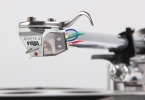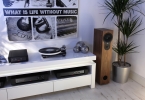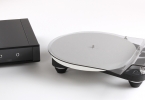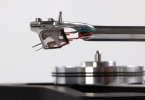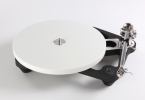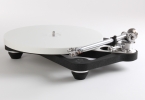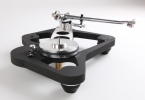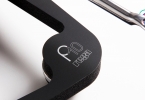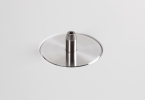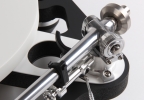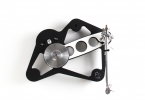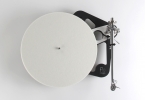Rega Planar 10 Turntable Review

One decade on from Rega’s return to records, the Planar 10 is the company’s brilliant new vinyl flagship – says David Price…
Rega
Planar 10 Turntable
AUD $7,799 ($9,499 with Apheta 3 MC Cartridge)

 Rega has been on a ten-year journey. In 2009 Roy Gandy realised that orders for his turntables had started to rise strongly – without the company spending any extra money on marketing them. At the same time, CD player sales gradually began to fall, so he made a conscious decision to focus back on vinyl, ratcheting up research and development and taking a careful look at his suppliers. One decade later, the new $7,799 Planar 10 is the result.
Rega has been on a ten-year journey. In 2009 Roy Gandy realised that orders for his turntables had started to rise strongly – without the company spending any extra money on marketing them. At the same time, CD player sales gradually began to fall, so he made a conscious decision to focus back on vinyl, ratcheting up research and development and taking a careful look at his suppliers. One decade later, the new $7,799 Planar 10 is the result.
“Ten years ago, the credit crunch hit the UK,” remembers Roy, “and Britain’s defence spending dropped, causing a number of companies that had previously been focused on aerospace to think about working with us on innovative new processes. This reminded me what a great country this is to do business. I’m not saying that for jingoistic reasons, but rather it’s because of the sheer breadth, depth and quality of our suppliers…”
Roy has duly spent the past decade making careful, iterative design changes to his turntables that have only been possible due to the adoption of new materials and processes. He stresses that this is thanks in no small part to the work done with his specialist suppliers and partners. “These very small gains in tolerances on turntable main bearings or tonearms are hard to market,” he says, “but we have done them nonetheless – because we can.” The legendary Naiad turntable of 2013 was the inflection point. This was a limited edition ‘statement’ turntable that Rega originally made as a design exercise, but which laid the groundwork for the deck you see before you.

Design Matters
Rega vinyl spinners are light, non-suspended belt drive decks, but many of today’s self-appointed analogue cognoscenti believe that only a turntable with an independently sprung subchassis can properly isolate the deck from ground-borne vibration. Failing that, they say it has to be hugely heavy à la Technics’ new SL-1000R – which uses sheer mass to damp out vibrations. And there’s also a school of thought that direct drive is the intellectually correct way to spin a record platter, rather than good old fashioned belt drive. Roy Gandy disagrees strongly on both points.
“There’s nothing magic about a turntable,” he says, “it’s a precision measuring instrument just like a microphone.” Roy believes that ground-borne vibration simply is not the big issue that many assume it is, telling me that his measurements show the room affects most decks only at -140dB or quieter. As such, he thinks there’s no need for sprung suspension, and indeed argues that it creates more problems than it solves in the grand scheme of things. That’s why the Planar 10 – and other Rega turntables – aren’t sprung. Also, they are light and rigid because he tells me, “mass absorbs energy – lost energy equals lost music.”
He also contends that it is perfectly possible to design an excellent drive system using a rubber belt and an AC synchronous motor, unlike a servo-controlled direct drive motor which is always hunting for the correct speed. Any speed variations on a belt drive system can satisfactorily be sorted by the proper design of the drivetrain, such as using ultra-high precision belts, careful motor mounting and platters of the correct material and mass, alongside a decent bespoke power supply.

Up Close
The chassis – or plinth, as Roy calls it – is unlike anything I have seen before. Its skeletal shape isn’t new, but its combination of materials is. “It’s amazingly light before you add the bearing”, he tells me. This is thanks to its Tancast 8 polyurethane foam construction, sandwiched between two layers of high-pressure laminate. It’s said to be a third lighter than the old RP10 predecessor, and more rigid too. Tap the chassis, and there’s a dull ‘dunk’ noise that’s practically gone before you hear it. It’s quite a contrast to turntables with an aluminium or steel chassis, which make a metallic ‘dang’ sound when you rap them with your knuckles.

Roy believes that the two most essential fixed points on a turntable are the main bearing and the tonearm bearing, and there cannot be any flex between them. To that end, he has braced the chassis between the two with ultra-strong ceramic on the upper side, and phenolic resin below. The main bearing assembly is manufactured to extremely high tolerances, Roy claims. A single-piece machined aluminium sub-platter and hardened tool steel spindle run inside a custom brass housing. On top of this sits the inner platter whose spindle runs in an oil bath in the bearing housing. Above this is the distinctive and rather beautiful ceramic platter, made from ceramic oxide powder which is compressed, fired and diamond-cut to ensure flatness across its surface.

Moving to the drive system, and as per tradition the Planar 10 uses a low noise, 24V AC synchronous motor. It’s specially mounted to the chassis in a way that keeps it as coupled as possible – for speed stability – while maintaining a high degree of vibration isolation. This technique was taken from the Naiad, and works in conjunction with Rega’s own new EBLT drive belt which is said to be ultra-consistent thanks to a special rubber curing system; it is said to have the same elasticity all around and dimensional correctness. Roy tells me that this is an order of magnitude better than that fitted to Rega decks of yore. The separate PL10 power supply uses digital signal processing and a crystal reference to supply a super-clean 24V. It’s said to divide the accurate square wave from the crystal to the exact frequency required to turn the platter at the selected speed. It hooks up to the deck via an XLR connector.
Last but not least is the new RB3000 tonearm. This may look very similar – polished finish notwithstanding – to the old RB300 of 1983, but Roy says the bearing housing and spindle are better than ever. This is thanks to a new manufacturing process claimed to give a micron-perfect fit, resulting in a friction-free tonearm. Like its radical forebear, it too has a one-piece headshell, armtube and bearing housing – one of few such designs to boast this on sale even now. It is made of aluminium rather than magnesium –à la SME – because Roy says the former is far easier to work with. Apparently, it can be shaved down to far lower thicknesses than magnesium and still be strong and stable. This, in turn, means that weight can be taken off where possible, making for a more sensible effective mass – so it can track a wide range of cartridges.

Finally, Rega’s brand new Apheta 3 moving coil cartridge was supplied on the review Planar 10; it costs $9,499 for the package. Watch out for a future review of this very capable pickup cartridge soon.
Sound Quality
One reason why so many vinyl junkies love turntables is that they have distinctive characters. Anyone old enough to have lived through ‘the golden age of vinyl’ of the nineteen-seventies, knows this all too well. You’ve got your ‘musical’ Linns, the ‘pile-driving’ Garrards, the ‘punchy’ Technics, the ‘spacious’ Michells, the ‘forensic’ Roksans and the ‘analytical’ SMEs, and so on. The interesting thing about the new Rega Planar 10 is that it’s none of these – it conspicuously lacks a distinctive personality to the point that on first acquaintance, some might actually find it rather bland. It doesn’t throw vast tracts of bass at you like a 301, or give you a vinegary bite of reality like an SL-1200G, or beguile its way into your heart as only – allegedly – an LP12 can. Instead, this deck just gets on with playing whatever is in the record groove, for better or for worse…
The new Rega has about as much character as a clean, optically correct glass lens – so in other words, its most obvious trait is that it hasn’t really got one. Cue up a piece of classic new wave like Siouxsie and the Banshees’ Israel for example, and it’s a case of being subtly drawn into the song. You’re immediately aware that the recording is less than perfect by modern standards – it’s a dry, late seventies rock sound with over-damped snare drums, direct injected bass guitar and scratchy electric guitar with heavy effects processing. Yet this deck just took me straight to the heart of the music, giving an open, detailed, rhythmic and dynamic sound that reminded me why I love this song so much.

Such translucency may be the Rega’s defining characteristic, but not its only one. Another is the delightfully deft way it handles rhythms and dynamics. I spend a lot of time listening to high-end direct drives and love what they do with the so-called ‘pace, rhythm and timing’ of music, yet the Planar 10 proves no poor relation. It’s less punchy and in-your-face than a high-end Technics, yet no less enjoyable. With 4hero’s Give In, I found myself zeroing-in on the brilliantly syncopated keyboard playing, snare drum, hi-hat and rimshot work. The keyboard player and drummer appeared to be locked into the groove with one another, the latter hovering very closely around the beat, but playing just loosely enough to give the track a gorgeously soulful feel. Indeed, the music ebbed and flowed along in an organic way that makes a Technics sound a little forced – thuggish even. I’m a huge fan of the latter, but the Rega really does hold a candle to it on this score, and some might think it even better still.
Then there’s the soundstaging. I’ve always thought this to be a forte of Regas, but here it is, further improved. Although not quite as expansive as a Michell GyroDec, it isn’t far off – whereas the SME Model 12 seems closed-in by comparison, and the SL-1200G ranks even further behind. For example, Trick of the Tail by Genesis – a mid-seventies rock classic – came over as positively panoramic. It felt like I could clearly hear the four walls of the recording studio, especially the vocal booth. Yet the Planar 10 doesn’t force stereo images right out at you as if they are artificially processed. Instead, its open window onto the recording lets you peer right on in. When inside, the listener is able to take in the precise location of each strand of the mix, both from left to right and front to back. I loved how the Rega carried the plaintive piano work that formed the centrepiece of this track.

Considering its relatively modest retail price, it’s hard to signpost any failings of the new Planar 10. Ultimately, high end ‘superdecks’ deliver greater impact. The wee Rega simply doesn’t have the vast bass of a top Technics or the dimensional scale of an SME – but those are far more expensive. Indeed, I think the only reason that some people won’t like the Planar 10 is its sheer matter-of-factness. Its lack of artificial colouration means that it doesn’t flatter poor recordings; rather it just tells you what’s going on in the groove. So if you’re playing the sublime Motown funk of Isaac Hayes’ Cafe Regios, the deck sounds sumptuous because that’s what this classic early seventies Stax recording is actually like. Yet cue up Kraftwerk’s The Telephone Call from the mid-eighties – done at the band’s own high tech Kling Klang studio – and the Rega sounds glass-clear to the point of starkness, which is just as it should be.
Overall then, this new turntable scores exceptionally well across the board, with no chinks in its armour to let the side down. Cue up a great piece of classical music, such as the first movement of Ralph Vaughan Williams’ Symphony No.2 [Sir Adrian Boult/London Philharmonic], and you sit there marvelling at the vanishingly low surface noise, excellent low-level detail retrieval, superlative speed stability, great dynamic handling, and limpet-like tracking on peaks. At the same time, there’s really nothing to lament, no sense of ‘if only it did this better, or didn’t do that’. The end result is the sound of beautiful music lapping at your feet, then crashing right out at you with all the majesty of one of the world’s finest orchestras in one of their best ever line-ups. It all sounds so natural, easy and organic – without so much as a hint of the processed feel that digital audio gives you, even at the high end. It’s delightfully fluid and flowing, as well as having a realistic, tangible texture that makes high-end vinyl such a rare and special experience.

The verdict
 Rather than indelibly stamping themselves on the music they play, Rega turntables have always been commendably smooth and self-effacing. The new Planar 10 carries on with this tradition but takes it to another level. The result is a superb sounding vinyl spinner, but one that doesn’t fit the traditional mould of cosy, warm sounding record players that some analogue addicts covet so much. Whether you enjoy this is solely down to you then, a matter of taste. For me, I think it isn’t for turntables to have character, that’s for their owners – so I love it.
Rather than indelibly stamping themselves on the music they play, Rega turntables have always been commendably smooth and self-effacing. The new Planar 10 carries on with this tradition but takes it to another level. The result is a superb sounding vinyl spinner, but one that doesn’t fit the traditional mould of cosy, warm sounding record players that some analogue addicts covet so much. Whether you enjoy this is solely down to you then, a matter of taste. For me, I think it isn’t for turntables to have character, that’s for their owners – so I love it.
For more information, visit Rega.
David Price
David started his career in 1993 writing for Hi-Fi World and went on to edit the magazine for nearly a decade. He was then made Editor of Hi-Fi Choice and continued to freelance for it and Hi-Fi News until becoming StereoNET’s Editor-in-Chief.
Posted in:Hi-Fi Applause Awards 2019 Turntables
Tags: rega synergy audio visual
JOIN IN THE DISCUSSION
Want to share your opinion or get advice from other enthusiasts? Then head into the Message Forums where thousands of other enthusiasts are communicating on a daily basis.
CLICK HERE FOR FREE MEMBERSHIP
Trending
applause awards
Each time StereoNET reviews a product, it is considered for an Applause Award. Winning one marks it out as a design of great quality and distinction – a special product in its class, on the grounds of either performance, value for money, or usually both.
Applause Awards are personally issued by StereoNET’s global Editor-in-Chief, David Price – who has over three decades of experience reviewing hi-fi products at the highest level – after consulting with our senior editorial team. They are not automatically given with all reviews, nor can manufacturers purchase them.
The StereoNET editorial team includes some of the world’s most experienced and respected hi-fi journalists with a vast wealth of knowledge. Some have edited popular English language hi-fi magazines, and others have been senior contributors to famous audio journals stretching back to the late 1970s. And we also employ professional IT and home theatre specialists who work at the cutting edge of today’s technology.
We believe that no other online hi-fi and home cinema resource offers such expert knowledge, so when StereoNET gives an Applause Award, it is a trustworthy hallmark of quality. Receiving such an award is the prerequisite to becoming eligible for our annual Product of the Year awards, awarded only to the finest designs in their respective categories. Buyers of hi-fi, home cinema, and headphones can be sure that a StereoNET Applause Award winner is worthy of your most serious attention.


